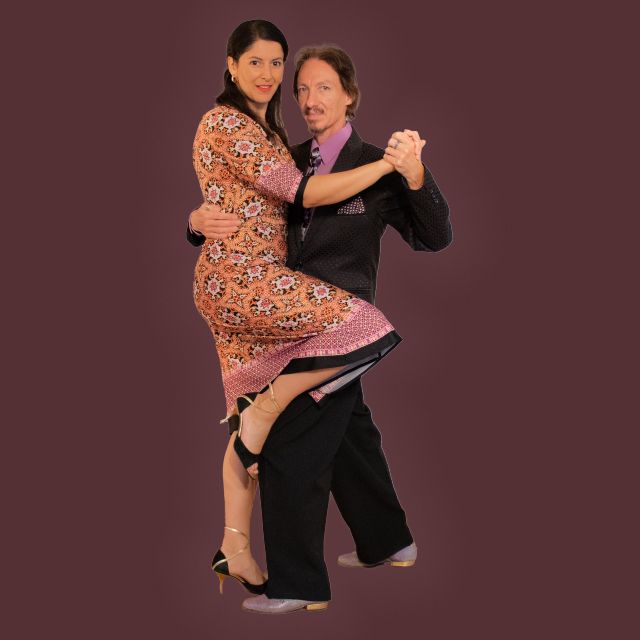About virtual Argentine Tango classes and private lessons
About virtual Argentine Tango classes and private lessons
Virtual classes are a powerful aid to the improvement of your dance, having always in mind the ultimate goal of dancing embraced.

In virtual classes, we are able to observe in detail our students dancing, and count on it as a magnificent tool to organize the presentation of our knowledge to them.
Even though what is unique to Tango are its in-person aspects, successful teaching methods will always require:
- Visual presentation.
- Clear explanation.
- Meticulous observation.
- Distanced objectiveness.
These elements are amplified in the case of virtual classroom technology.

We strongly advise you not to miss this opportunity.
Virtual classes help you to understand things differently, making you pay attention to aspects often passed on at the in-person classes, and facilitating you to make your communications more clear and efficient.
Here we want to share with you what we consider important for you in the process of virtual Argentine Tango instruction:
For students:
-
Be open-minded.
Take advantage of what only virtual classes can offer to you.For instance, since your teacher cannot dance with you or physically move you, he or she will break down the movements into its most elemental constituents, helping you to fully understand what movements and how to execute them, in a way that will provide you with the opportunity to practice the move in a “timeless” and “spaceless” fashion, a more thoughtful way, and eventually a more aware way. -
Let experience teach you.
Since this is going to be a novel way to learn Argentine Tango, you will find on your path problems that will be only resolved with later corrections.For instance, your floor may not be the best for dancing Tango, or your furniture gets in your way, or your internet connection is too slow.All these are problems that get fixed much more easily than fixing your Tango. Go ahead and move your furniture, look at hardware stores online for plastic tiles that you can put over your carpet, call your internet provider.At each class you will get a better set up for your learning environment. And since we are a community, please share your questions regarding solutions to these challenges. I like to ask my students how they are fixing their particular problems, so I may be in the possession of an answer for you already. -
Pay attention.
Avoid distractions. If you are not alone at home, let your relatives and spouses know that you’ll be “away” for one hour.Even though you are physically at home, you are virtually at your Tango class. This “virtuality” is very real. You need to be fully engaged in your class. You won’t be able to be in two places simultaneously.Even if it is your living room or garage, it is the classroom for the duration of the lesson. -
Ask questions.
Do not hesitate. Your instructors need constant feedback to know that the communication is effective.Let them know you did not understand something, or you could not see it, or whatever passes your mind that is related to what is worked on during the class.Your teacher has modified his/her teaching style to the online channel, so you need to change your usual learning actitudes. Even technical questions related to the technology used for the class are admissible questions.
For teachers:
-
Plan your class.
You will need to adapt your teaching style to the TV or computer screen’s two dimensional space.Keep in mind that your student needs to see you all the time. That is why turns are particularly challenging to teach in the virtual class set up, but not impossible.My solution to this problem is to segment the turns in its constituents, in order to keep training a fundamental element of Tango, avoiding making students having to look at the screen while they turn away. -
Have the right tools.
Supply yourself with a good camera and a good microphone. Since your communications will be exclusively visual and auditory, you need the best tools that you can provide yourself.
I’ve been using a mini iPad for the camera and a wireless microphone. I like to show the moves having students behind me, so I am doing the with the camera at my back, so the microphone has been essential to make the sound clear even while I am talking looking away fro the camera.
Although I have to say the iPad and Zoom (the video conference system that we use) are very sensitive in picking up the sound waves.
-
Have good lighting.
I am using all the lights of my home studio pointed at me, and added an extra lamp with a styrofoam board to reflect light on my face when I get close to the camera.
-
Use screen sharing to play your music.
This will make your students hear to the music you choose for your class with much better sound quality than if you make it stream from your microphone.
-
Keeping things in order.
Use the waiting room feature and close the admission at ten minutes into the class to avoid interruptions.
You can also have an assistant to work as admin. That is my case but it may not be yours.
Here are some examples of what we have been working in our virtual classes:
Learn to dance Argentine Tango at our virtual classes

























